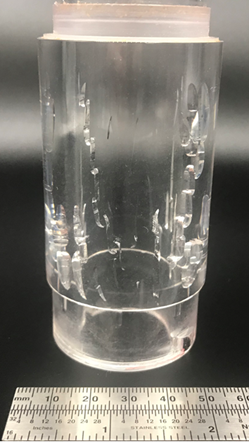

Polymer properties can permanently change as they age, which can lead to unexpected failures. These failures can be avoided by considering the polymer’s response to the environment during early product design. Liquids, gases, heat, and irradiation can have irreversible chemical effects on a polymer. Alternatively, in some cases the polymer can affect the liquid’s properties. Both situations can cause unwanted medtech product failures. Some of the most common types of degradation are hydrolysis, oxidation, and chain-scission.
- Polymer hydrolysis – Cleaning products cause your plexiglass screen to become hazy from induced crazing.
- Polymer oxidation – Heat and light from devices left in a car can combine with oxygen to make polymer products weak and brittle. An example is an epinephrin auto-injector that may be left in the car. It is under high stress due to containing large springs, so if the polymer embrittles, the device could crack.
- Polymer chain scission – Too many heat/shear processing cycles cause resins to have reduced molecular weight and decreased strength. This can happen to resins during multiple compounding cycles in which fillers and colorants are added.
- Polymer sterilization – Gamma irradiation, ethylene oxide gas, and autoclaving all can cause polymer degradation (discoloration, decreased strength, etc.) in medical devices if the polymer is not resistant.
- Liquid degradation – Drug formation stabilizers can absorb into polymers leaving the drug destabilized with reduced efficacy.
Hydrolysis is initiated through contact with water, acids, or bases. The rate of the degradation increases as a function of increased temperature, increased acidity, or increased basicity. The degradation proceeds through cleavage of the polymer backbone, thus decreasing its molecular weight and reducing its strength. Some sanitizers used in the healthcare industry can initiate high rates of hydrolysis. For example, a 10% bleach solution that is used to wipe down equipment between uses has a very basic pH of 13. After repeated wiping the material can degrade to the point of discoloration, crazing, or even fracturing. Polymers most susceptible to hydrolysis include polycarbonate, polyamides, polyurethanes, polyacetals, and polyesters. Polycarbonates are clear and used as protective barriers but can become hazy after multiple cleanings.
One of the most common tests to assess hydrolysis of a polymer to a liquid is through monitoring of environmental stress cracking (ESC). There are standard methods for performing ESC testing, such as ASTM D1693. Essentially, a bar of the polymer is put under a constant strain and submerged into the challenge liquid. The time and temperature of the submersion are controlled, and the polymer is inspected for signs of degradation (discoloration, crazing, cracking, swelling, etc.) at periodic intervals. This test can be run at accelerated conditions so that long-term polymer performance can be predicted from short-term testing.
Another type of polymer degradation is oxidation of which there are two main forms, photo and thermal. Photo-oxidation occurs from the energy carried by light, most commonly ultraviolet (UV) radiation from the sun. Thermal oxidation occurs more rapidly at elevated temperatures, but also occurs at ambient temperatures over a longer time, as seen in Figure 1. Both types require oxygen from the atmosphere. Oxidation uses free radicals found in the polymer along with oxygen to cleave covalent bonds in the polymer backbone. This type of degradation reduces the polymer molecular weight, reduces strength, and embrittles the polymer. Autoclave sterilization can cause oxidation and has similar effects on polymer properties due to its high temperature. Polymers with low glass transition temperatures, like PVC, are more susceptible to this degradation.

induced from years of ambient
oxidation.
Polymer chain scission occurs more often in plastics that experience high temperatures and shear rates for longer times. Most polymer parts for medical devices are injection molded. These polymers are routinely compounded more than once. Fillers are compounded into the polymers to add strength or barrier properties, while colorants enhance aesthetics. The compounding is performed at high temperature and high shear in a mixing extruder. Then, the parts are shaped by injection molding, which is again accomplished at high temperature and shear. The chain scission experienced during each processing cycle causes decreased strength and increased unwanted long-term properties like creep. Similarly, gamma irradiation as a sterilization method also causes chain scission in some polymers, such as PTFE. On the other hand, gamma sterilization causes polymer cross-linking in others, such as polyethylene.
The most common effects of polymer chemical degradation have been discussed, but there also can be an effect on the contacting fluid. Many drug delivery devices have a wetted fluid path that the drug travels before delivery to the patient. Drug formulations contain stabilizers, such as cresol, and some polymers readily absorb cresol. This decreases the percentage of stabilizer in the formulation, which destabilizes it and can cause denaturization of the drug, rendering it less efficacious. The ultimate consequence of this sequence is that the patient receives a lower active dose than prescribed.
As discussed here, polymers can fail in many ways depending on their chemical make-up and the environments they are exposed to. However, a fundamental understanding of polymers can be used to intelligently select the best material of each product, thus avoiding costly failures.
Do environmental or chemical factors affect the quality and longevity of your plastic products? EWI can help. Contact Jeff Ellis at [email protected] or 614.688.5114 to learn more.
To read more articles about avoiding material failure in plastic products, click here